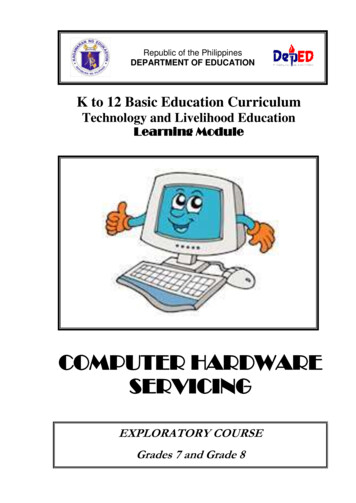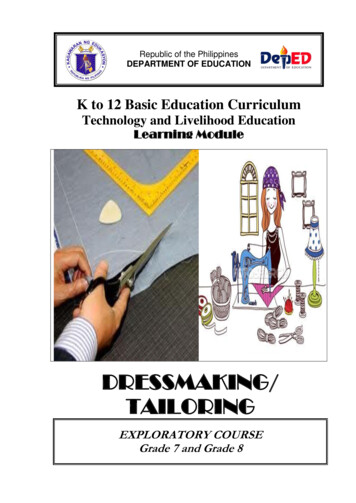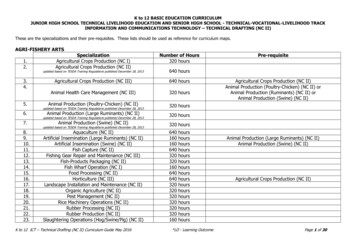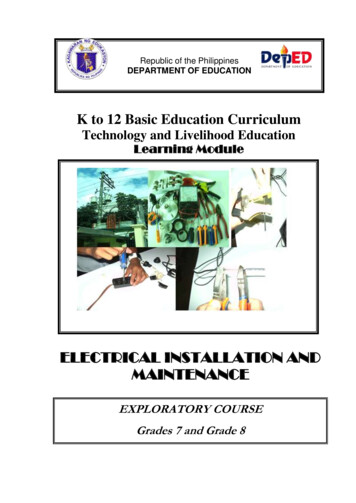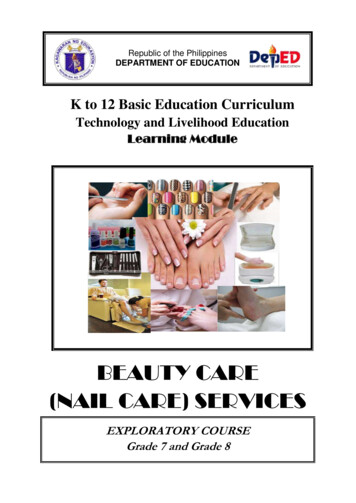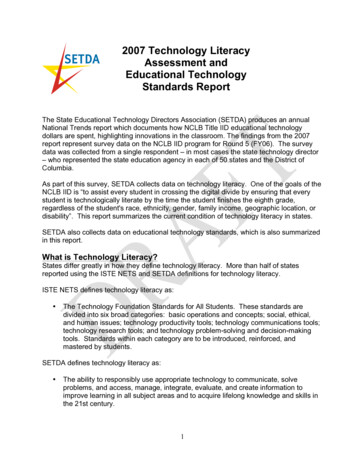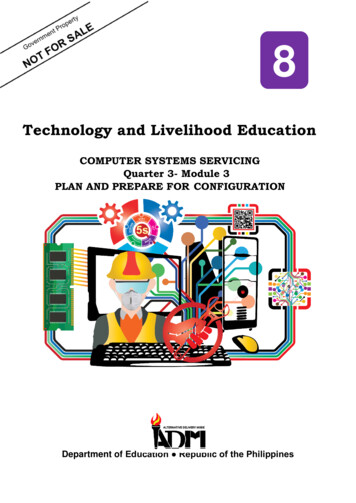
Transcription
8Technology and Livelihood EducationCOMPUTER SYSTEMS SERVICINGQuarter 3- Module 3PLAN AND PREPARE FOR CONFIGURATIONDepartment of Education Republic of the Philippines
What I Need to KnowThis module covers the knowledge, skills, attitudes and values needed to perform computeroperations which include the basic maintenance of computer system and the standards ofOccupational Health and Safety (OHS) Policies and Procedures.The module is divided into two lessons, namely:Lesson 1 – OHS Policies and ProceduresLesson 2 – Basic Computer System MaintenanceAfter going through this module, you are expected to:1. Plan and prepare for tasks to be undertaken(TLE IACSS9-12PCO-Ic-d-4)2. Maintain computer equipment and systems (TLE IACSS9-12PCO-Ii-j-9)What I KnowBefore starting with this module, let us measure what you already know about PerformingComputer Operations. Follow and answer the activity below.Instructions: Read the statements carefully then write True if the statement is correct and write Falseif it is wrong. Write your answer in your TLE CSS Activity notebook.1. Occupational Safety and Health (OSH) refers to the legislation, policies, procedures, andactivities that aim to protect the health and safety of all people at the workplace.2. Work alone so that nobody can take care in case of emergencies.3. Do not turn off the computer before cleaning the system unit.4. Take away any liquid near your working area.5. Be careful with tools that may cause short circuit.6. Place parts or tools wherever you like.7. Place your computer near an electronic socket to avoid trailing wires across the floor.8. Before using any chemicals for electronic equipment, always read the warnings andinstructions on the label.9. Always ground or discharge yourself before touching any part of the computer.10. Use excessive force if things don’t quite slip into place.11. The goal of Computer Ergonomics is to prolong strain, fatigue and injuries of the bodywhile using the computer.12. Do not clean the area before and after using it to maintain sanitation.13. Hold the components on the edges.14. 5s for Personal Computer decreases organization and productivity.15. Too many unused files or folders make your computer more active.- 1-
Lesson1Occupational Health and Safety (OHS)Policies and ProceduresWhat’s InIn the previous lesson, you have learned the different parts of the computer system. Inperforming the different computer operations, you must be mindful of your safety and health. Thecomputer system also must be maintained properly to be more efficient and effective when use. Keepon track because the next lesson will show you more interesting and helpful things which you coulduse while using the computer.What’s NewActivity 1: Reveal MeDirections: Search for the six (6) different words related to OHS Policies and Hazards. Encircle theword/ words vertically, horizontally, backward, upward, or downward.- 2-
What is itBefore going to perform some computer operations, you must observe the proper safetyprocedures for you to keep away from harm, injury, or even death.OHS POLICIES AND PROCEDURESOHS or Occupational Health and Safety refer to the legislation, policies, procedures, andactivities that aim to protect the health, safety, and welfare of all people at the 33721111. Do not work alone so that someone can take care of you in case of emergency.2.Always power off the computer and unplug the computer before working on it.3.Take away any liquid near your working area to avoid getting electrocuted or accidentallydamaging computer parts.4.Be careful with tools that may cause short circuit.5. Always ground or discharge yourself before touching any part of the computer.6. Do not use excessive force if things don't quite slip into place.7. Clean the area before and after using it to maintain sanitation and prevent accidents.8.Hold the components on the edges and do not touch the Integrated Circuit (IC) parts.9. Always wear personal protective equipment (PPE) in accordance with the organization's OHSprocedures and practices.10. Make sure that the pins are properly aligned when connecting a cable connector.11. Emergency measures during workplace accidents, fire, and other emergencies are recognized.12. Use brush, compressed air or blower in cleaning the computer system.- 3-
5s for the Personal ComputerYou work with documents, presentations, graphics, and other files all day – and chances are,you have a lot of them. Stop the file clutter by managing your files more effectively. 5s conceptprovides the foundation for all quality improvement programs. It results to an increase of dailyproductivity and better 17/Step 1: Sort (Seiri)Too many unused files and folders slow you and your computer down. Remove or discardwhat is not needed so that there are fewer hazards and less clutter to interfere with work. Only keepwhat is needed.Step 2: Set In Order (Seiton)There must be place for everything. Organize your files and folders to reduce clutter and allowfor instant access:1) Establish a naming convention for files. This will make files easier to locate2) Create a folder system for organizing your work. Tips include:- 4-
Step 3: Shine (Seiso)1) Cleaning your computer and check your computer for problems:a. Clean your computer screen.b. Clean the key board.c. Clean all cables and ensure free from dust.d. Clean computer main box.e. Run system diagnostic/maintenance utilities Anti‐virus Disk defragmentation Anti‐spyware f. Clean the start menu2) Audit that you are saving files using the correct naming conventions, and that namingconventions are being used in shared locations as well.Step 4: Standardize (Seiketsu)Develop consistency in practices over time.Step 5: Sustain (Shitsuke)Allocate 5 minutes a week to run through organization of your PC. Remember, 5 minutes cansave the effort you spend to search through unnecessary clutter! Studies show that you can use yourcomputer twice as efficiently if you organize it well!What’s MoreActivity 2: Mark MeDirections: Read the statements carefully. Mark check ( ) if the statement follows the OSH policiesand procedures, otherwise mark wrong ( ). Write your answer on your TLE CSS activitynotebook.1. Work alone so that nobody can take care of you in case of emergency.2. Always power off the computer and unplug the computer before working on it.3. Take away any liquid near your working area to avoid getting electrocuted or accidentallydamaging computer parts.4. Be careful with tools that may cause short circuit.5. Always ground or discharge yourself before touching any part of the computer.- 5-
Lesson2Basic Computer System MaintenanceWhat is ItBasic Computer System MaintenanceJust like getting an oil change for the car, maintaining the computer is crucial to keeping itsecure and in good working condition. Good computer maintenance will not only make sure thecomputer is running optimally but will also protect your valuable data from cybersecurity threats.Computer maintenance is the practice of keeping computers in a good state of repair. FoldersFolders are used to organize and categorize files in your computer storage AntivirusUse the antivirus to check your computer, flash drives and other storage devices forany files infected with viruses and malware. Make sure that your antivirus has thelatest update.- 6-
BackupCreating a backup of your files will give you the assurance that if something goeswrong with your file, you can still retrieve a duplicate of your file from your backupstorage. System UpdateSystem Updates were designed to address software and security issues and problemsin our computers. This ensures safe computing.To update your operating system, just follow the steps below:1. Click on the Windows 10 start button2. Click the Settings – the one with gear-liked icon.3. In the windows Settings that would appear on your screen, scroll down to Updateand Security and click it.4. In the Windows update window, click Check for updates. Restart your computerafter the installation of updates.- 7-
TENDER, LOVING CARE (TLC)Here are some things that you should always remember to give your computer the tender,loving care it needs.1. Always keep your computer free from dust, grime, and all kinds of dirt. Wipe it every other daywith a soft, lightly damp, lint-free cloth. The keyboard should also be disinfected with alcoholwipes.2. Place your computer, speaker, scanner, and printer atop a sturdy surface. Your computertable should be strong enough to hold their entire weight.3. Slightly cold weather is ideal for computers. If the weather is too hot, turn off your computerunit.4. Avoid cluttering up the space around your computer.5. Keep all liquids and food items away from your computer because they can damage delicateelectronic circuits. Liquids can also cause serious electrical shock if spilled on the computer.6. Wash your hands before using the computer to avoid “sticky keys”.What I Have LearnedDirections: Fill in the missing word/s to complete the sentence. Write your answers in a sheet ofpaper with your Name, Grade and Section, your TLE Specialization.1. Occupational and Safety refers to the legislation, policies, procedures, andactivities that aim to protect the health, safety, and welfare of all people at the workplace.2. concept provides the foundation for all quality improvement programs.3. is the science of designing equipment for safe and comfortable workingenvironment.4. are used to organize and categorize files in your computer storage.5. System were designed to address software and security issues and problemsin the computers.- 8-
AssessmentTrue or falseInstructions: Read the statements carefully then write TRUE if the statement is correct and writeFALSE if it is wrong. Write your answers in a sheet of paper with your Name, Gradeand Section, your TLE Specialization.1. Occupational Safety and Health (OSH) refers to the legislation, policies, procedures, andactivities that aim to protect the health and safety of all people at the workplace.2. Work alone so that nobody can take care in case of emergencies.3. Do not turn off the computer before cleaning the system unit.4. Take away any liquid near your working area.5. Be careful with tools that may cause short circuit.6. Place parts or tools wherever you like.7. Place your computer near an electronic socket to avoid trailing wires across the floor.8. Before using any chemicals for electronic equipment, always read the warnings andinstructions on the label.9. Always ground or discharge yourself before touching any part of the computer.10. Use excessive force if things don’t quite slip into place.11. The goal of Computer Ergonomics is to prolong strain, fatigue and injuries of the bodywhile using the computer.12. Do not clean the area before and after using it to maintain sanitation.13. Hold the components on the edges.14. 5s for Personal Computer decreases organization and productivity.15. Too many unused files or folders make your computer more active.- 9-
Activity 21.2.3.4.5. - 10 -What I KnowAssessment1. True1. True2. False2. False3. False3. False4. True4. True5. True5. True6. False6. False7. False7. False8. True8. True9. TrueActivity 19. True15. True MAINTAIN15. True14. False OCCUPATIONAL14. False13. True STANDARD13. True12. False HEALTH12. False11. True SAFETY11. True10. False COMPUTER10. FalseAnswer Key
You work with documents, presentations, graphics, and other files all day - and chances are, you have a lot of them. Stop the file clutter by managing your files more effectively. 5s concept provides the foundation for all quality improvement programs. . Audit that you are saving files using the correct naming conventions, and that naming .

